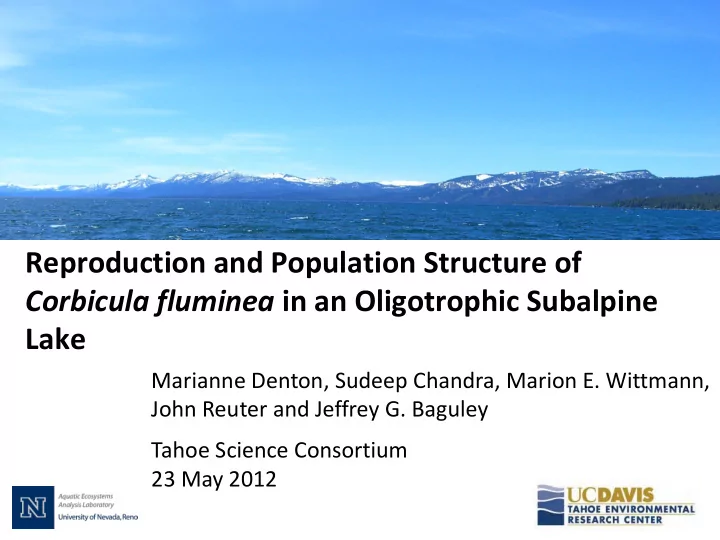

Reproduction and Population Structure of Corbicula fluminea in an Oligotrophic Subalpine Lake Marianne Denton, Sudeep Chandra, Marion E. Wittmann, John Reuter and Jeffrey G. Baguley Tahoe Science Consortium 23 May 2012
Outline • C. fluminea Reproduction • 2009 Preliminary Study • 2010 Complete Study – Locations – Food Availability – Temperature – Reproductive Effort – Population Structure • Results & Conclusions – Thougths About Temperature 3
How Does C. fluminea Reproduce? Illustrations modified from Invertebrate Anatomy OnLine. 4 Richard Fox, Lander University.
How Does C. fluminea Reproduce? Simultaneously hermaphaditic producing gametes (eggs & sperm) in the gonads. Gametes (eggs & sperm) move into the demibranches (gills). Sperm is released into the water column and either self-fertilizes or fertilizes a close neighbor. Egg fertilized in the demibranches. Developing juveniles are brooded in the marsupial gills. Illustrations modified from Invertebrate Anatomy OnLine. 5 Richard Fox, Lander University.
Ovum with jelly coating embedded with sperm Fertilized egg Adult, simultaneous Blastula hermaphroditic 24 hours Asian Clam. 6 to 14 Day Straight-Hinged Juvenile Developmental Gastrula 12 – 24 hours Cycle Pediveliger Trochophore Trochophore 24 – 96 hours 24 – 48 hours 24 – 48 hours Veliger 24 – 48 hours Black and White images from 6 Kraemer, L.R. and M.L. Galloway, 1986.
Gills are a Great Place! 7
2009: Marla Bay Egg Veliger 8
2009: Nevada Beach Egg Veliger 9
10 (Tahoe Environmental Research Center)
Summer 2010 on Lake Tahoe Lakeside 5 m Marla Bay 5 m Nevada Beach 5 m Nevada Beach 20 m Map courtesy of Dave Rios, 2011 11
2010 Study Design Temperature would have the greatest In situ temperature at each site influence on the timing of reproduction (°C) • Total Organic Carbon (mg/L) Food availability would influence overall • Sediment Particulate Organic reproductive effort Matter ( g/mg) Reproductive Effort Reproductive efforts would be similar in • Number of Eggs both shallow and deeper populations • Number of Veligers resulting in a source of veligers for Population Structure populating the nearshore environment • Mean Abundance (#clams/m 2 ) 12
Bivoltine Reproduction 2 nd Juveniles Spawn Spawned in the 1 st Spring are Spawn Reproductive Adults by Fall Increase in Temperature Suppresses Spawning 13
It’s Warm Enough for C. fluminea to Reproduce LS 5m MB 5m NVB 5m NVB 20m 25.0 20.0 Temperature (°C) 15.0 10.0 Spermatogenesis (10°C) Fertilization (14-15°C) 5.0 Release of Juveniles (16-18°C) 0.0 11-May 29-May 16-Jun 28-Jun 7-Jul 20-Jul 2-Aug 16-Aug 30-Aug 13-Sep 8-Oct 5-Nov Date 2010 14
Food Availability is Important for Reproduction 80 60 Spawning Animals (%) 60 45 Chlorophyll-a ( g/l) 40 30 20 15 0 0 Jan Feb Mar Apr May Jun Jul Aug Sep Oct Nov Dec 1992 Rajagopal et al, 2000. Reid et al, 1992.
Food Availability : Total Organic Carbon LS 5m MB 5m NVB 5m NVB 20m 12 TOC (mg/L) 10 8 11-May 29-May 16-Jun 28-Jun 7-Jul 20-Jul 2-Aug 16-Aug 30-Aug 13-Sep 8-Oct 5-Nov Date 2010 16
Food Availability: Sediment Particulate Organic Matter 17
Eggs Veligers Reproductive Effort Light Dark Bars Bars 18
Others Studies Show Populations Have a Lot of Juveniles 19 Hall, 1984.
Abundance Number of Clams/m 2 Lakeside 5 m 1252 144 Marla Bay 5 m 1664 202 Nevada Beach 5 m 1689 162 Nevada Beach 20 m 2541 291 20
What’s Going on with Nevada Beach 20 m? 21
Dispersal via Floatation Mucus Thread Stained with Carbon Siphons Foot Prezant and Chalermwat, 1984 22
Physical Action within Tahoe Wittmann et al. 2011 23
How are Tahoe’s C. fluminea different? 10 2 (n=603) • 588 (Spring) and 735 (Fall) per clam per • day 286 28 (4% with 100) • • Annual high of 1,800 (late June) to 1200 20 2 (12% with <100) • (early October) per clam per day • 498 had no veligers (84%) Aldridge and McMahon. 1978. Doherty, et al. 1987. 24
Results & Conclusions • Hypothesis: Temperature would influence reproductive timing – Univoltine beginning in mid-August – Delay in spawn • Hypothesis: Locations with greater food availability would have an increased reproductive effort – Sediment particulate organic matter was greater at Lakeside, this did not influence overall reproductive effort – Total organic carbon was not different between sites • Hypothesis: Deeper water population would have similar reproductive effort as shallow populations – No reproductive effort – High abundances • Population structure shows a strong adult population with a minimal juvenile population indicating that deeper water populations are likely a sink population rather than a source 25
Acknowledgments Funding SNPLMA Science funding via the USDA PSW Research Station Nevada License Plate Funds from the Nevada Division of State Lands Aquatic Ecosystems Analysis Laboratory, Tahoe Environmental Research Center, University of Nevada, Reno UCDavis Annie Caires Geoff Schaldow Joe Sullivan Katie Webb John Umek Raph Townsend Robert Barnes Steve Sesma Jessica Rassmussen Alex Denton Christine Ngai California Fish and Game Jim Moore, Bodega Marine Laboratory, UCDavis Tahoe-Baikal Institute SEE 2009 Asian Clam Project Group 26
Questions? Marianne Denton mariannedenton@sbcglobal.net
Recommend
More recommend